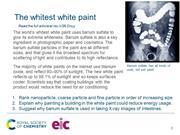How the whitest white paint ever could make us less reliant on air conditioning

Download this
A starter slide to give your 14–16 students a new context for exploring particle size and nanoparticles, or as an example of uses of ionic substances.
The world’s whitest white paint could provide a cheap way to cool our homes: simply paint the whole building with it.
The paint’s extreme whiteness is due to very high levels of barium sulfate, which is a key ingredient in photographic paper and cosmetics, and is also used in school analysis tests for sulfate. This paint appears to be the nearest white counterpart to Vantablack, which is one of the blackest substances known and was developed in 2014 by UK-based Surrey NanoSystems. The barium sulfate particles in the product are all different sizes, and that gives it the broadest spectrum for scattering of light and contributes to its high reflectance.
The majority of white paints on the market use titanium oxide as a filler and reflect 80–90% of sunlight. The new white paint reflects up to 98.1% of sunlight. This is a significant improvement over the 95.5% reflected by paint the same research team created last year using a formulation based on calcium carbonate. By comparison, Vantablack absorbs up to 99.9% of visible light.
The new white paint also keeps surfaces cooler than its previous iteration. Scientists say that coating buildings with the product would reduce the need for air conditioning.
Put this in context
Read about a scientist at AkzoNobel helping to create more renewable energy for longer by providing coatings that ensure wind turbine blades can resist erosion and UV degradation giving them a lifespan of 25 years.
Read the full story in Chemistry World.
Downloads
Whitest white paint EiC starter slide
Presentation | PowerPoint, Size 1.84 mbWhitest white paint EiC starter slide
Presentation | PDF, Size 0.19 mb















No comments yet